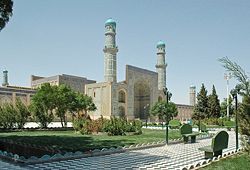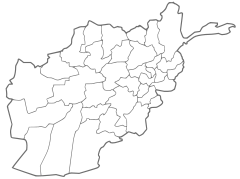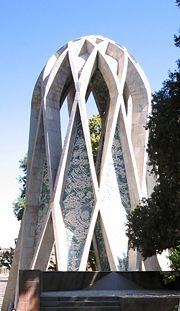Herat
| Herat هرات |
|
|---|---|
 |
|
 Herat |
|
| Province | Herat |
| Coordinates | |
| Population (2006) |
349,000 (3rd) Central Statistics Office of Afghanistan |
| Area - Elevation |
920 m (3,018 ft) |
| Time zone | UTC+4:30 Kabul |
Herāt (Persian: هرات), classically called the Aria, is a city in western Afghanistan, in the province also known as Herāt. It is situated in the valley of the Hari River, which flows from the mountains of central Afghanistan to the Karakum Desert in Turkmenistan. Situated in a fertile area, Herāt was traditionally known for its wine. It is the third largest city in Afghanistan, with a population of 349,000 (2006 official estimate). Persian-speaking Tājiks (or Fārsīwān) are the main inhabitants of the city and are roughly the same as the Persians of Eastern Iran.[1][2]
Herat is an ancient city with many historic buildings, although these have suffered damage in various military conflicts during the last few decades. The city is dominated by the remains of a citadel constructed by Alexander the Great. During the Middle Ages Herat became one of the important cities of Khorasan, and it was known as the Pearl of Khorasan.
Herāt is situated favorably on the ancient and historic trade routes of the Middle East, South Asia, Pakistan,China, India and Europe. The roads from Herāt to Iran, Turkmenistan, Mazar-e Sharif and Kandahar are still strategically important.
Contents |
History

Herat dates back to ancient times, but its exact age remains unknown. In Achaemenid times (ca. 550-330 BC), the surrounding district was known as Haraiva (in Old Persian), and in classical sources the region was correspondingly known as Aria (Areia). In the Zoroastrian Avesta, the district is mentioned as Haroiva. The name of the district and its main town is derived from that of the chief river of the region, the Hari River (Old Iranian Harayu "with velocity"), which traverses the district and passes just south (5 km) of modern Herat. The naming of a region and its principal town after the main river is a common feature in this part of the world. (Compare the adjoining districts/rivers/towns of Arachosia and Bactria.)
The Persian Achaemenid district of Aria is mentioned in the provincial lists that are included in various royal inscriptions, for instance, in the Behistun inscription of Darius I (ca. 520 BC).[3] Representatives from the district are depicted in reliefs, e.g., at the royal Achaemenid tombs of Naqsh-e Rustam and Persepolis.

Herodotus called Herat as the bread-basket of Central Asia. At the time of Alexander the Great, Aria was obviously an important district. It was administered by a satrap, called Satibarzanes, who was one of the three main Persian officials in the East of the Empire, together with the satrap Bessus of Bactria and Barsaentes of Arachosia. In late 330 BC Alexander the Great, captured the Arian capital that was called Artacoana. The town was rebuilt and the citadel was constructed. It became part of the Seleucid Empire but was captured by others on various occasions and became part of the Parthian Empire in 167 BC.
In the Sasanian period (226-652), "Harev" is listed in an inscription on the Ka'ba-i Zartosht at Naqsh-e Rustam; and "Hariy" is mentioned in the Pahlavi catalogue of the provincial capitals of the empire. In around 430, the town is also listed as having a Christian community, with a Nestorian bishop.
In the last two centuries of Sasanian rule, Aria (Herat) had great strategic importance in the endless wars between the Sasanians, the Chionites and the Hephthalites who had been settled in modern northern Afghanistan since the late fourth century.
Islamic conquest

The city of Herat became well known with the advent of the Arabs in the middle of the seventh century. When the Arab armies appeared in Khorasan in the 650s, Herat was counted among the twelve capital towns of the Sasanian Empire. Herat was taken in AD 652 by General Abdul Rehman ibn Samrah. Around 786-809 Herāt was part of the Abbasid caliphate, later, it was ruled by the Tahirid dynasty, and after 867-869, the Saffarid dynasty took control.
Before 1040 it was ruled by the Ghaznavids. In 1040 it was captured by the Seljuk Empire. In 1175 it was captured by the Ghorids and then came under the Khawarazm Empire. In this period Herāt became an important center for the production of metal goods, especially in bronze, often decorated with elaborate inlays in precious metals.
In 1221 it was captured by the Mongols and later destroyed by Genghis Khan. In 1245 it was given to the Kart Maliks.
Around 1381 it was destroyed again by Timur. Under his son Shah Rukh it was rebuilt and became an important center under the Timurid Empire. In the late 1400s the Musalla complex (with many minarets) was built under the rule of Queen Gawharshad. Her tomb complex is considered one of the great monuments of Timurid architectural carving.
The Black Sheep Turkomans (Qara Qoyunlu) at one point established their capital in Herat during the fifteenth century, and [4] in 1506 it was captured by the Uzbeks and a few years later was taken back by Shah Ismail Safavi, to become part of a new Safavid Persian Empire.
Modern history

From 1718 until 1863, there were various battles fought between the natives of the city and the Afghans until the city became part of present-day Afghanistan. Ahmad Shah Durrani took possession of Herat in 1750, which became part of the Durrani Empire after almost a year of siege and bloody conflict. In 1824, the city became effectively independent when the country was split in three to resolve a succession struggle. The city was taken back by the Persians in 1852 and again in 1856; both times the British helped to reverse the attempt, the second time through the Anglo-Persian War. The city was taken by Dost Mohammed Khan in 1863, making it part of a broader "Afghan state".
Most of the Musallah complex in Herat was cleared in 1885 by the British army to get a good line of sight for their artillery against Russian invaders who never came.
During the Democratic Republic of Afghanistan Herat was used by the Soviets. Even before the Soviet invasion at the end of 1979, there was a substantial presence of Soviet advisors in the city with their families. From 10 to 20 March 1979 the army in Herat under the control of Ismail Khan mutinied and some 35 Soviet citizens were killed. The Afghan air force bombed the city, causing massive destruction and some 10,000 deaths and it was recaptured with tanks and paratroopers.
Ismail Khan became the leading Mujahedin commander in Herat and after the departure of the Soviets he became governor of Herāt. In September 1995 the city was captured by the Taliban and Ismail Khan fled. However, after the U.S. invasion of Afghanistan, on November 12, 2001, it was liberated from the Taliban by the Northern Alliance and Ismail Khan returned to power (see Battle of Herat). In 2004, Mirwais Sadeq Khan, who was Aviation Minister of Afghanistan and the son of Ismail Khan, was ambushed and killed in Herat. More than 200 people were arrested on suspicion of involvement.[5]
Herat is presently a part of Afghanistan's new central government, which is led by United States backed President Hamid Karzai. There are also NATO peacekeeping forces present in and around the city providing security led by Italy.
Transport
Air
- Herat Airport
Rail
In 2007, Iran and Afghanistan finalized an agreement for the establishment of a rail service between the two countries. Construction of the 191 km railway, from Khaf in Iran to Herat, is in progress on the Iranian side of the border [6]. There is also the prospect of an extension across Afghanistan to Sher Khan Bandar.
Tourism and sightseeing

- City Districts
- Shar Noe (Downtown)
- Walayat (Office of the governor)
- Qol-ordue (Army's HQ)
- Farqa (Army's HQ)
- Durwaza Khush
- Char-suq
- Pull-rangina (also called: Pull- rangina)
- Sufi-abad
- Noe-abad
- Pull-malaan
- Thakh-ta Safar
- Howz-a-Karbas
- Baramaan
- Darwaza Qandahar
- Darwaza Iraq
- Darwaza Az Kurdistan

- Hotels
- Serena Hotel (coming soon)
- Diamond Hotel
- Marcopolo Hotel
- Monuments
- Citadel of Alexander
- Musalla Complex
- Museums
- Herat National Museum (currently closed, relocating to the Citadel)
- Jihad Museum

- Shrines
- Tomb of Queen Gawarshad
- Tomb of Mirwais Sadiq
- Tomb of Jami
- Tomb of Kwaja Qaltan
- Mosques
- Juma Mosque (Friday Mosque)
- Kazir-gah Sharif
- Khalgha Sharif
- Shah Zahdaha
- Parks
- Park-e Taraki
- Park-e Millat
- Khana-e Jihad Park
- Stadiums
- Herat Stadium
- Universities
- Herat University
Famous people from Herat
- Khwājah Abdullāh Ānsārī, a famous Persian poet of the 11th century
- Nūr ud-Dīn Jāmī, a famous Persian Sufi poet of the 15th century
- Nizām ud-Din ʿAlī Shīr Navā'ī, famous poet and politician of the Timurid era
- Ustād Kamāl ud-Dīn Behzād, the greatest of the medieval Persian painters
- Gowharšād, wife of Shāhrūkh Mīrzā
- Mīrzā Shāhrūkh bin Tīmur Barlas, Emperor of the Timurid Dynasty of Herat
- Mīrzā Husseyn Bāyqarāh, Emperor of the Timurid Dynasty of Herat
- Shāh Abbās The Great, Emperor of Safavid Persia
- Abbas Gholi Khan Shamlu (Governor of Herat, 1812)
- Mowlānā Fayzānī, famous reformer and philosopher of the 20th century
- Amir Jan Sabouri - famous composer and singer from Adraskan District
- Valy Hedjasi - famous singer, born in Mashhad but a native of Herat
Herat in fiction
- The beginning of Khaled Hosseini's 2007 novel A Thousand Splendid Suns is set in and around Herat.
References
- ↑ Center Of Afghanistan Studies, University of Nebraska: "Ethnic composition of Afghanistan" in National Geographic Magazine, 2003
- ↑ H. F. Schurmann, The Mongols of Afghanistan: an Ethnography of the Moghols and Related Peoples of Afghanistan. The Hague: Mouton, 1962: [1]; p. 75: "... the Tajiks of Western Afghanistan [are] roughly the same as the Khûrâsânî Persians on the other side of the line ..."
- ↑ Translated by Herbert Cushing Tolman. "The Behistan Inscription of King Darius". Vanderbilt University, Nashville, Tennessee.
- ↑ Patrick Clawson. Eternal Iran. Palgrave Macmillan. 2005 ISBN 1-4039-6276-6 p.23
- ↑ "More arrests after Herat killing", BBC News (2004-03-25).
- ↑ Railway Gazette: Opening up Afghan trade route to Iran
This article incorporates text from the Encyclopædia Britannica Eleventh Edition, a publication now in the public domain.
See also
- Herat Province
- History of Afghanistan
- Aria (satrapy)
- Greater Khorasan
External links
- Heratonline.com : Information and news about Herat
- Herat.co.uk
- Detailed map of Herat city
- Herat a leading city in Afghanistan
- Photo Gallery of Herat
- Poyaa.com - Local News From Herat
- FallingRain Map - elevation = 933m
|
|||||
|
||||||||||||||||
